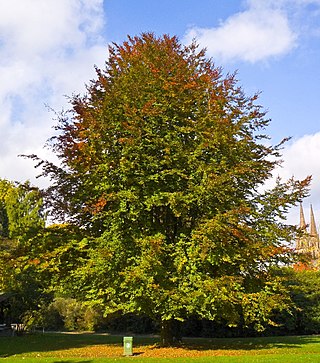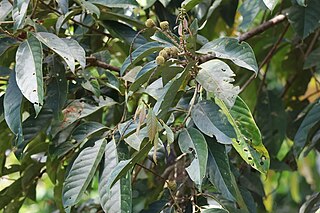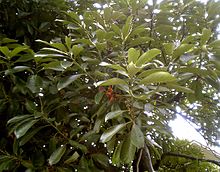
An oak is a hardwood tree or shrub in the genus Quercus of the beech family. They have spirally arranged leaves, often with lobed edges, and a nut called an acorn, borne within a cup. The genus is widely distributed in the Northern Hemisphere; it includes some 500 species, both deciduous and evergreen. Fossil oaks date back to the Middle Eocene. Molecular phylogeny shows that the genus is divided into Old World and New World clades, but many oak species hybridise freely, making the genus's history difficult to resolve.

The Fagaceae are a family of flowering plants that includes beeches, chestnuts and oaks, and comprises eight genera with about 927 species. Fagaceae in temperate regions are mostly deciduous, whereas in the tropics, many species occur as evergreen trees and shrubs. They are characterized by alternate simple leaves with pinnate venation, unisexual flowers in the form of catkins, and fruit in the form of cup-like (cupule) nuts. Their leaves are often lobed, and both petioles and stipules are generally present. Their fruits lack endosperm and lie in a scaly or spiny husk that may or may not enclose the entire nut, which may consist of one to seven seeds. In the oaks, genus Quercus, the fruit is a non-valved nut called an acorn. The husk of the acorn in most oaks only forms a cup in which the nut sits. Other members of the family have fully enclosed nuts. Fagaceae is one of the most ecologically important woody plant families in the Northern Hemisphere, as oaks form the backbone of temperate forest in North America, Europe, and Asia, and are one of the most significant sources of wildlife food.

Castanopsis, commonly called chinquapin or chinkapin, is a genus of evergreen trees belonging to the beech family, Fagaceae. The genus contains about 140 species, which are today restricted to tropical and subtropical eastern Asia. A total of 58 species are native to China, with 30 endemic; the other species occur further south, through Indochina to Indonesia and the Philippines, mountainous areas of Taiwan, and also in Japan. The English name chinkapin is shared with other related plants, including the golden chinkapins of the Pacific United States, which are sometimes included within Castanopsis but are more often considered a separate but very closely related genus, Chrysolepis.
Lithocarpus hendersonianus is a tree species in the beech family Fagaceae. Trees in the genus Lithocarpus are commonly known as stone oaks and differ from Quercus primarily because they produce insect-pollinated flowers. This tree species is endemic to Peninsular Malaysia. It is categorized as Vulnerable by the IUCN Red List of Threatened Species, primarily due to habitat loss.
Quercus asymmetrica is an oak tree species in the beech family Fagaceae. It is found in China and northern Vietnam. It is placed in subgenus Cerris, section Cyclobalanopsis.

Notholithocarpus densiflorus, commonly known as the tanoak or tanbark-oak, is a broadleaf tree in the family Fagaceae, and the type species of the genus Notholithocarpus. It is native to the far western United States, particularly Oregon and California. It ranges from 15–40 meters in height, with a trunk diameter of 60–190 centimeters.
Quercus kouangsiensis is an uncommon Asian species of trees in the beech family Fagaceae. It has been found only in southern China, in the Provinces of Guangdong, Guangxi, Hunan, and Yunnan. It is placed in subgenus Cerris, section Cyclobalanopsis.
Lithocarpus caudatifolius is a tree in the beech family Fagaceae. The specific epithet caudatifolius means "leaf with caudate apex".
Lithocarpus coopertus is a tree in the family Fagaceae. The specific epithet coopertus means "covered over", referring to the acorn.

Lithocarpus echinifer is a tree in the beech family Fagaceae. The specific epithet echinifer is from the Latin meaning "having straight spines", referring to the cupule.
Lithocarpus encleisacarpus is a tree in the beech family Fagaceae. The specific epithet is from the Greek meaning "enclosed fruit", referring to the acorns and cupules. The cupule is not fused to the nut though and often becomes irregularly dehiscent. The degree to which the nut is enclosed by the cupule varies across its geographic range. Trees in Lithocarpus are commonly known as the stone oaks and differ from Quercus primarily because they produce insect-pollinated flowers.

Quercus hiholensis is an extinct species of oak in the Fagaceae genus Quercus. The species is known from Middle Miocene fossils found in Central Washington.
Quercus petelotii is the accepted name of an endemic oak tree species in the beech family Fagaceae; there are no known sub-species. It is placed in subgenus Cerris, section Cyclobalanopsis.
Quercus subsericea is a tree species in the beech family Fagaceae. There are no known subspecies. It is placed in subgenus Cerris, section Cyclobalanopsis.
Lithocarpus jacobsii is a tree in the beech family Fagaceae. It is named for the Dutch botanist Marius Jacobs. Trees in Lithocarpus are commonly known as the stone oaks and differ from Quercus primarily because they produce insect-pollinated flowers.
Lithocarpus kalkmanii is a tree in the beech family Fagaceae. This species is named for the Dutch botanist Cornelis Kalkman.
Lithocarpus revolutus is a tree in the beech family Fagaceae. The name is derived from the way in which the margins of the leaves are typically rolled in upon themselves (revolute). Trees in Lithocarpus are commonly known as the stone oaks and differ from Quercus primarily because they produce insect-pollinated flowers.

Quercus subgenus Cerris is one of the two subgenera into which the genus Quercus was divided in a 2017 classification. It contains about 140 species divided among three sections. It may be called the Old World clade or the mid-latitude clade; all species are native to Eurasia and North Africa.











